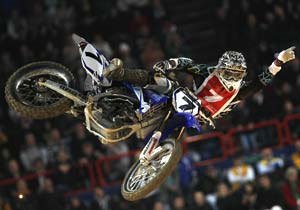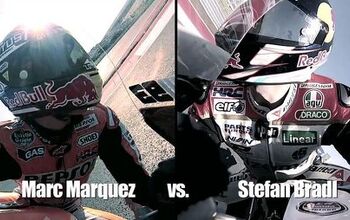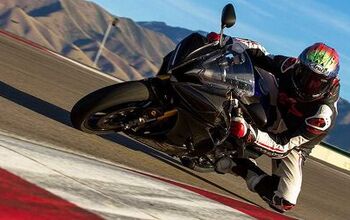What is It About Racing?
Editor’s Note: This article is an excerpt from the new book “ The Ride So Far: Tales from a Motorcycling Life,” published by Whitehorse Press. The hardback explores a diverse range of subjects surrounding motorcycles. Part 1’s chapters discuss Great Places & Memorable Rides, with chapters like “Ode To A Road” and ‘Almost Heaven For Riding. Part 2, titled Ruminations & Meditations, is a bit more philosophical, with chapter titles like “How I Survived Myself” and “What My Motorcycle Taught Me About Women.”
The author, Lance Oliver, is a longtime motorcyclist with a far-ranging breadth of experiences. He was until recently a magazine and website editor for the American Motorcycle Association. This excerpt discusses why some riders are rabid motorcycle racing fans, while many other riders have no interest in the subject. Which one are you?
The rider hunches himself tighter than a jockey on a thoroughbred, his neck jerked back at an inhuman angle, his chest pressed against the metal of the gas tank, which pounds his sternum when even the slightest bump comes too hard and too fast for the taut suspension to damp it. He hears his own engine screaming between his knees, its pistons violently reversing direction dozens of times per second, but he also hears the sound of another screaming engine, another motorcycle, somewhere over his shoulder, ridden by another, equally adrenaline-powered, hyper-competitive racer, who desperately wants nothing more on earth than to be in front of him. So he holds, holds, forces himself to hold the throttle as the braking marker rushes toward him, and at the last possible moment before the only outcome imaginable is a tumbling crash, he sits up into the 190-mph wind blast to slow for the right hand corner ahead. Now comes the really hard part.
Despite the wind desperately trying to rip him off the bike, despite the speed and the acceleration and braking forces of his hurtling flight, his every move must be as precise as a surgeon’s. Every part of his body goes to work, every synapse of mental processing power called into play to sense every twitch from the bike and to maximize the precision of the instructions to all those parts of the racer’s body. Two fingers of his right hand squeeze the front brake lever, tensely seeking the point of maximum deceleration, which lies just this side of front wheel lockup and disaster. The left hand pulls the clutch while the left foot shifts down through the gears, and the right hand, already busy with its most crucial task of braking, works the throttle to keep the revs in line with the downshifting. The legs begin shifting his weight to the right, in one fluid motion, careful not to unsettle the already strained chassis, preparing to hang off for the turn. The upper body strains against the wind blast over the top of the small fairing, a strain that must not be fed into the handgrips, because the front tire, already at the limit, can take no more inputs.
The stresses on the front tire heat it to the melting point, the strands of rubber compound melting and reforming at a microscopic level, leaving behind the tell-tale feathering typical of a spent tire at the end of a race. With the weight of the motorcycle and rider fully shifted to the front tire, the rear tire rises off the ground slightly, skimming the asphalt, a forgotten follower, for the moment, as all the action is taking place at the front. The rear of the bike moves side to side slightly, like a dog wagging its tail in super slow motion, the rider keeping the motorcycle’s two wheels roughly in line with minor changes in his position and pressure on the grips, so minor and instinctual after years and years of riding, that he doesn’t think of them, they just happen.
As he begins his lean in the corner, he’s still trailing the front brake, but much more lightly now, as almost all the front tire’s precious traction must be reserved for cornering, leaving little for braking. Hanging off the right side of the bike, knee scraping the asphalt, elbow barely flying above the raised red-and-white curb, eyes intently looking through the apex of the turn, mind already thinking beyond the demands of this second to what must come next, the crucial moment when the right hand can again twist the throttle and desperately call for enough power from the engine and enough grip from the shredding rear tire to stay ahead of the other riders on the same edge of their ability and their motorcycles’ capabilities.
That’s one corner of one race. String them together for an entire race, then an entire season of races, and if your ability to find that fine line between mastery and disaster is among the best in the world, you may achieve riches and glory. If you’re off by a couple of seconds a lap, you may make a better living as an accountant. You’ll certainly be less likely to be maimed on the job.
In case you can’t tell, I love this stuff. I admire the skill, I enjoy the spectacle.
I realize not everyone does.
It’s one of those things that adds to the diversity of motorcycling and sometimes also leaves me mystified. There are hundreds of thousands of avid riders in this country who have never been to a race, couldn’t name one top rider, and probably couldn’t even say for sure what kind of motorcycles are raced professionally. I can understand that. What a boring world it would be if we all liked the same things. The mystifying part is the visceral objection to racing I find among some riders. They’ve gone beyond “I don’t care for it and have no interest,” to “If I see one more race bike on the cover of your magazine I’m going to cancel my subscription.” Meanwhile, on a summer Sunday in Italy, the top-rated program on television is likely to be a MotoGP race, and more than 100,000 people will flock to the same race in Spain. Even in our country, there are thousands of kids training and working to be the best at their local motocross track, hoping to be the next Ricky Carmichael or James Stewart. It’s one of those motorcycle sub-cultures that go unnoticed by many riders, but its intensity is hard to overestimate.
Personally, I enjoy many kinds of racing, both two wheels and four. If I were an off-road rider I’d probably pay more attention to motocross or enduros. An epic like the Dakar Rally captures my attention just because of the sheer demands it places on the racers’ stamina, endurance, and mental strength. But it should come as no surprise that the form I most enjoy is motorcycle roadracing. It’s the closest to what I do, which is ride a street motorcycle, though once you understand the skill involved at the professional level, you come to realize it’s not really all that close.
That skill gap between amateurs and pros is there in any sport. The best player in the local YMCA recreational basketball league is only superficially playing the same game as an NBA player. Similarly, even a very competent street rider who works at being smooth and thinks of himself as a fast rider is a wounded slug compared to the pros. Having taken the Kevin Schwantz and Jason Pridmore riding courses, I’ve been on the track with several pros. As I rode near my limit, they cruised comfortably ahead of me, demonstrating proper technique and preferred lines, operating video cameras, monitoring my form in their mirrors and generally not breaking a sweat. They had several more gears they could shift into if needed, but for riding with the likes of me, they could turn off 75 percent of their skills.
If more evidence is needed, do a track day sometime at one of the tracks the AMA Superbikes visit. Time your laps, and see just how far off the pace you are. It’s sobering. How do you make up 20 seconds a lap? And then, consider this: Those guys are racing at the national level. They haven’t made it to the top two rungs, World Superbike or MotoGP. Then there’s motocross, where we’re fortunate to have the national championship that attracts the world’s best riders and has thus become the de facto world championship. I had the chance once to walk the Supercross track at Qualcomm Stadium in San Diego before the racing started. The jumps are steep enough to make walking difficult. Riding it? At speed? Fast enough to keep James Stewart in sight? Sure, right after I dunk on Lebron James and pound my way through the Colts front line to sack Peyton Manning.
While I don’t expect everyone who rides to appreciate racing, I’m often frustrated by the huge gap in popularity between four-wheel and two-wheel racing in this country. It’s not that I expect people who have never ridden a motorcycle to suddenly start attending Superbike weekends. But why do so many motorcycle riders seem to prefer car racing?
On a trip around Lake Superior in 2002, I found myself in Munising, Michigan on a Sunday evening. The hotel had a banquet room that doubled as a bar, and since there were no events going on, it was empty except for the bartender and a big-screen television, showing some random program. Fortunately, the bartender was happy to hunt down the Speed channel at my request and I was able to relax at the end of the day’s ride and watch another chapter in the truly epic battle that year between Colin Edwards and Troy Bayliss for the World Superbike championship. If you saw any of that 2002 season, you know what I mean. American versus Aussie, Honda versus Ducati, a back-and-forth thrust and parry that culminated with Edwards overcoming a 58-point deficit to seal the title in the final laps of the final race of the season. As I watched that race in the empty hotel hall in July, most of the drama was still to come, but every race that season was one not to be missed.
The next morning, I joined some other riders for breakfast and one asked in casual fashion, “Anybody hear who won the race yesterday?”
I almost launched into an enthusiastic, turn-by-turn description of the Bayliss-Edwards battle, but something made me stop short. “Which race?” I asked. My fellow riders told me they were interested in who won the weekend’s NASCAR race. Since I’d caught a glimpse of the results while watching the World Superbike race, I knew the answer. “Kevin Harvick,” I said, a little glumly. No offense to Kevin Harvick, but even the name sounded boring when I said it, compared to the hand-to-hand duel I’d witnessed. I considered trying to tell them what they’d missed, what they continued to miss, but decided against it.
Much as I might wish that those fellow riders would prefer watching Ducati, Honda and Yamaha Superbikes to Fords and Toyotas and Chevys that in reality all look exactly alike, I know a losing battle when I see one. I could make all kinds of rational arguments about why motorcycle roadracing is superior to NASCAR. The higher fitness level of motorcycle racers. The greater physical demands of motorcycle racing, as shown by the average age that riders retire, versus drivers who keep going sometimes into their 50s. The ability of fans to see the rider working the motorcycle, while the cars are just chunky billboards, with the drivers’ skills, no matter how masterful, hidden from view inside.
All logical arguments, but in the end, logic has little to do with it. An appreciation for racing is not something that comes from a rational examination of facts or statistics. It’s a gut feeling. It is certainly increased by an informed appreciation for the skill involved, but it still comes down to the excitement of the flash of color as a racing motorcycle roars down a straight, the sound of controlled and harnessed explosions trailing behind, the tires struggling for grip as the rider tests the foothold at the edge of the abyss. You either get hooked or you don’t. In the end, that’s what it is about racing.
More by Lance Oliver
































Comments
Join the conversation